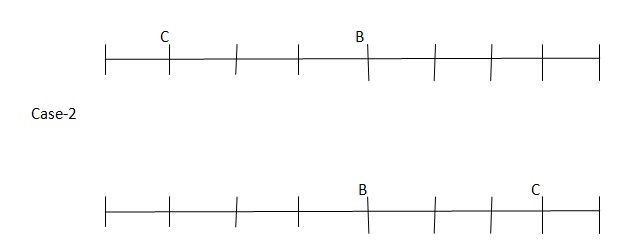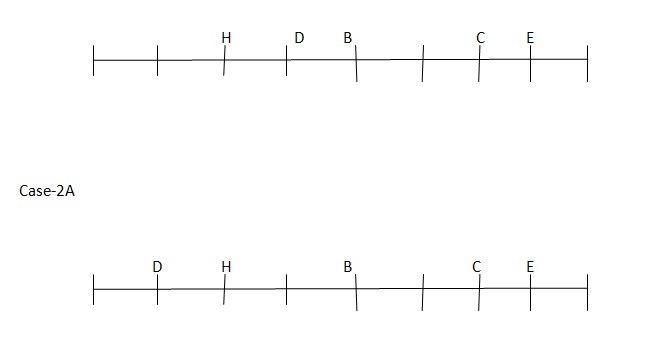Question
Which of the following statements is/are not true
regarding I? Study the following information carefully and answer the given questions: There are nine persons i.e. A, B, C, D, E, F, G, H and I are sitting in a linear row. All of them are facing in the north direction. B sits at the middle of the row. Two persons sit between C and B. E is an immediate neighbour of C and sit at the end of the row. H sits third from the left end of the row. D is an immediate neighbour of H. Number of persons sit to the right of F is equal to the number of persons sit to the left of H. I sits exactly between B and F. At least one person sits between G and A who does not sit at the end of the row.Solution
B sits at the middle of the row. As per this statement, the arrangement will look like this:  Twopersons sit betweenCand B. Asperthisstatement,therearetwopossiblecases andthearrangementwill look like this:
Twopersons sit betweenCand B. Asperthisstatement,therearetwopossiblecases andthearrangementwill look like this:  EisanimmediateneighbourofCandsit at the end ofthe row. H sits third from the left end of the row.As per this statement, the arrangement will look like this
EisanimmediateneighbourofCandsit at the end ofthe row. H sits third from the left end of the row.As per this statement, the arrangement will look like this  DisanimmediateneighbourofH. Asperthisstatement, CASEII willfurthergetsplitintoone more case and the arrangement will look like this:
DisanimmediateneighbourofH. Asperthisstatement, CASEII willfurthergetsplitintoone more case and the arrangement will look like this:  Case-2
Case-2  NumberofpersonssittotherightofFisequalto the number ofpersonssit to theleft of H. IsitsexactlybetweenBandF. At least one person sits between G andAwho does notsitat theendoftherow. As per this statement, CASE I and CASE II will geteliminated and we will continue with CASE II (A) andthefinal arrangement will look likethis:
NumberofpersonssittotherightofFisequalto the number ofpersonssit to theleft of H. IsitsexactlybetweenBandF. At least one person sits between G andAwho does notsitat theendoftherow. As per this statement, CASE I and CASE II will geteliminated and we will continue with CASE II (A) andthefinal arrangement will look likethis: 
In the following question, among the four answer figures which one can be formed from the cut out pieces given below?
A piece of paper is folded and cut as shown below in the question figures from the given answer figures, indicates how it will appear when unfolded? ...
A piece of paper is folded and cut as shown below in the question figures. From the given answer figures, indicate how it will appear when opened?
...A paper is folded and cut as shown below. How will it appear when unfolded?
In the following question, among the four answer figures which one can be formed from the cut out pieces given below?

Choose a figure which would most closely resemble the unfolded form of Figure (Z).
In the following question, among the four answer figures which one can be formed from the cut out pieces given below?
In the following question, among the four answer figures which one can be formed from the cut out pieces given below?
Among the four answer figures, which can be formed from the cutpieces given below?
Relevant for Exams:



